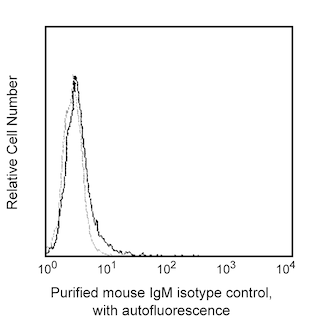Old Browser
This page has been recently translated and is available in French now.
Looks like you're visiting us from {countryName}.
Would you like to stay on the current country site or be switched to your country?


Regulatory Status Legend
Any use of products other than the permitted use without the express written authorization of Becton, Dickinson and Company is strictly prohibited.
Preparation And Storage
Recommended Assay Procedures
Functional Studies: Anti-Lewis[x] monoclonal antibody (clone MMA) has been used to determine Le[x] expression on normal and neoplastic cells in studies of tumor metastasis, together with sialyl-Le[x] (CD15s), E-selectin (CD62E) and Pselectin (CD62P) monoclonal antibodies.
Immunohistology: Anti-Lewis[x] monoclonal antibody (clone MMA) can be used in staining formalin-fixed paraffin-embedded tissue sections of normal prostate, colon, stomach, brain and lymphoid tissues, adenocarcinomas of lung and urinary bladder. The MMA monoclonal antibody also stains neuraminidase-treated, formalin-fixed, paraffin-embedded sections of normal, metaplastic and neoplastic cervical epithelium.
Immunoblotting: Anti-Lewis[x] monoclonal antibody (clone MMA) can be used to detect Le[x] in membranous glycoprotein cell or tissue extracts by immunoblotting.
Cell ELISA: Anti-Lewis[x] monoclonal antibody (clone MMA) can be used to detect Le[x] on HL-60 promyelocytic, HT-29 colon cancer or F9 teratocarcinoma cells.
Product Notices
- Since applications vary, each investigator should titrate the reagent to obtain optimal results.
- Please refer to www.bdbiosciences.com/us/s/resources for technical protocols.
- Caution: Sodium azide yields highly toxic hydrazoic acid under acidic conditions. Dilute azide compounds in running water before discarding to avoid accumulation of potentially explosive deposits in plumbing.
Companion Products

.png?imwidth=320)
Reacts with the Le[x] blood group antigen, lacto-N-fucopentaose III or the CD15 antigen. The Le[x] determinant is expressed on normal cells and tissues of diverse origin, including myelomonocytic cells, myoepithelial cells in prostate, glandular epithelial cells including breast, renal cell and hepatocellular carcinomas, lung and urinary bladder adenocarcinomas and Reed-Sternberg cells in Hodgkin's disease.
Development References (13)
-
Bevilacqua MP, Nelson RM. Endothelial-leukocyte adhesion molecules in inflammation and metastasis. Thromb Haemost. 1993 July; 70(1):152-154. (Biology). View Reference
-
García Prats MD, López Carreira M, Martínez-González MA, Ballestín C, Gil R, De Prada I. Granular cell basal cell carcinoma. Light microscopy, immunohistochemical and ultrastructural study. Virchows Arch A Pathol Anat Histopathol. 1993; 422(2):173-177. (Biology). View Reference
-
Grignon DJ, Ro JY, Ayala AG, Johnson DE, Ordóñez NG. Primary adenocarcinoma of the urinary bladder. A clinicopathologic analysis of 72 cases. Cancer. 1991 April; 67(8):2165-2172. (Biology). View Reference
-
Groves RW, Allen MH, Ross EL, Ahsan G, Barker JN, MacDonald DM. Expression of selectin ligands by cutaneous squamous cell carcinoma. Am J Pathol. 1993; 143(4):1220-1225. (Biology). View Reference
-
Hanjan SN, Kearney JF, Cooper MD. A monoclonal antibody (MMA) that identifies a differentiation antigen on human myelomonocytic cells. Clin Immunol Immunopathol. 1982 May; 23(2):172-188. (Biology). View Reference
-
Hsu SM, Huang LC, Hsu PL, et al. Biochemical and ultrastructural study of Leu M1 antigen in Reed-Sternberg cells: comparison with granulocytes and interdigitating reticulum cells. J Natl Cancer Inst. 1986 August; 77(2):363-370. (Biology). View Reference
-
Ma CK, Zarbo RJ, Frierson HF Jr, Lee MW. Comparative immunohistochemical study of primary and metastatic carcinomas of the liver. Am J Clin Pathol. 1993 May; 99(5):551-557. (Biology). View Reference
-
McCormick BA, Zetter BR. Adhesive interactions in angiogenesis and metastasis. Pharmacol Ther. 1992; 53(2):239-260. (Biology). View Reference
-
Narita T, Funahashi H, Satoh Y, Watanabe T, Sakamoto J, Takagi H. Association of expression of blood group-related carbohydrate antigens with prognosis in breast cancer. Cancer. 1993 May; 71(10):3044-3053. (Biology). View Reference
-
O'Hara CJ, Corson JM, Pinkus GS, Stahel RA. ME1. A monoclonal antibody that distinguishes epithelial-type malignant mesothelioma from pulmonary adenocarcinoma and extrapulmonary malignancies. Am J Clin Pathol. 1990 Februaru; 136(2):421-428. (Biology). View Reference
-
Paties C, Taccagni GL, Papotti M, Valente G, Zangrandi A, Aloi F. Apocrine carcinoma of the skin. A clinicopathologic, immunocytochemical, and ultrastructural study. Cancer. 1993 January; 71(2):375-381. (Biology). View Reference
-
Torii A, Nakayama A, Harada A, et al. Expression of the CD15 antigen in hepatocellular carcinoma. Cancer. 1993 June; 71(2):3864-3867. (Biology). View Reference
-
Zhou Q, Moore KL, Smith DF, Varki A, McEver RP, Cummings RD. The selectin GMP-140 binds to sialylated, fucosylated lactosaminoglycans on both myeloid and nonmyeloid cells. J Cell Biol. 1991; 115(2):557-564. (Biology). View Reference
Please refer to Support Documents for Quality Certificates
Global - Refer to manufacturer's instructions for use and related User Manuals and Technical data sheets before using this products as described
Comparisons, where applicable, are made against older BD Technology, manual methods or are general performance claims. Comparisons are not made against non-BD technologies, unless otherwise noted.
For Research Use Only. Not for use in diagnostic or therapeutic procedures.